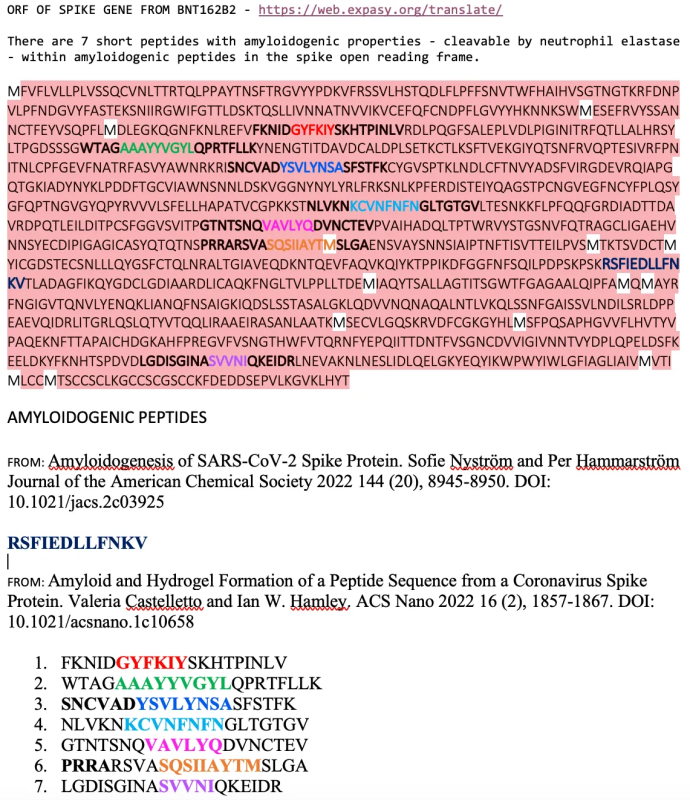All of the harms from the COVID-19 injectable products were predictable, and preventable.
Jessica Rose, PhD
A Nature publication by Mulroney et al. entitled N1-methylpseudouridylation of mRNA causes +1 ribosomal frameshifting was published on December 6, 2023. The authors showed that N1-methylpseudouridine affects the fidelity of mRNA translation via ribosome stalling resulting in the production multiple, unique, and potentially aberrant proteins by frameshifting.
To address concerns associated with these findings, Wiseman et al. quickly penned Ribosomal frameshifting and misreading of mRNA in COVID-19 vaccines produces “off-target”proteins and immune responses eliciting safety concerns: Comment on UK study by Mulroney et al.
Some of the concerns arise from the codon-optimization of the modified mRNAs for use in the COVID-19 products. Codon optimization was done to achieve maximal protein expression in humans. It is based on the fact that specific organisms prefer to use specific codons called codon bias. We can exploit codon bias by crafting mRNAs according to the protein host producer using synonymous codon replacement, to increase translational efficiency and protein expression, without altering the sequence of the protein.
However, it is well known that codon-optimization can lead to protein conformation, folding, and stability problems whereby it may disrupt the fine-tuned timing of translation and ultimately protein function. Codon optimization can also lead to misfolding of mRNAs due to increased Guanine/Cytosine (GC content) in the optimized mRNA.
Synonymous codon replacement also results in a change in the multifunctional regulatory and structural roles of resulting proteins.
There is, in fact, a significant enrichment of GC content (17% and 25% enrichments as per Pfizer and Moderna, respectively, as compared to SARS-CoV-2) as a result of the codon optimization that was done, and “this can lead to disease-associated cellular pathologies involving G4-quadruplexes” linked to prion diseases. Increased GC content significantly alters mRNA secondary structure as well, and this can also lead to ribosomal pausing or stalling.
In addition to problems anticipated with codon optimization, the replacement of all of the Uridines to N1-methylpseudoridines in the mRNA used for the production of the COVID-19 injectable products lends to higher infidelity translation of proteins. The authors claim that slippery sequences – long runs of N1-methylpseudoridines – induce frameshifting whereby the ribosome simply slips over these sequences to shift the reading frame to produce entirely different proteins. According to their findings, this happened about 8% of the time. If we contextualize this finding to the in vivo human setting, the numbers of aberrant proteins that might be being produced is staggering.
A University of Cambridge write-up entitled Researchers redesign future mRNA therapeutics to prevent potentially harmful immune responses was also penned. The take-home message from this summary was that the modified mRNA COVID-19 product platform can be rescued by simply ameliorating the slippery sequences responsible for the frame-shifting, by targeting them and mutating the slippery codons.
I would not recommend sliding down this very slippery sequence slope.
A note on on- and off-target protein production
I can think of at least two potentially looming problems pertaining to protein production in the context of the COVID-19 modified mRNA products.
- On-target proteins being produced with high fidelity
- Off-target proteins being produced with low fidelity
The potential for amyloidogenic protein production is present in the context of on-target protein production. It has been shown that a conserved coronavirus spike protein peptide forms amyloid nano-structures and hydrogels under pH-dependent (pH = 4) conditions. It has also been shown that a molecular mechanism for potential amyloidogenesis of SARS-CoV-2 S-protein in humans is facilitated by endoproteolysis by neutrophil elastase.
Figure 1 demonstrates that there are at least 8 amyloidogenic peptides in the spike protein as per the BNT162b2 code. My concern is that in the context of high fidelity translation, at least one of these peptides are produced and cleaved into amyloidogenic peptides to induce proteinopathy. The degree and type of damage will depend on the locations of proteins being produced.

An even more recent preprint paper published online on December 9, 2023, demonstrates spontaneous formation of the amyloid-like self-assembling nanostructures of spike and N proteins that might induce proteinopathy or amyloidosis. This means that it’s possible that spike proteins produced in the human setting might be forming amyloids to induce neurodegeneration and other pathologies.
The potential for aberrant protein production is also present in the context of off-target protein production as per the newly published Nature paper referenced above. The authors show that off-target proteins are being produced in the context of the COVID modified mRNA shots due to out-of-frame translation. This so-called ‘frameshifting’ is likely enhanced by the combination of codon optimization and the replacement of Uridines to N1-methylpseudouridines.
The fact that off-target proteins are being produced is very concerning. These proteins could induce an unintended immune response against proteins leading to autoimmunity, especially in the context of chimeric spike-human peptides.
Combining 1. and 2. conceptually, molecular mimicry hotspots in the spike protein have already been discovered with autoimmune potential in the context of thrombocytopenia. A TQLPP motif in the spike protein shares similar antibody binding properties to the human protein thrombopoietin. Antibodies cross-reacting with thrombopoietin may induce thrombocytopenia, a condition observed in COVID-19 patients. The modified mRNA that encodes the spike in the BNT162b2 and Moderna COVID-19 shots are mimicked after the spike protein from SARS-CoV-2 virus.
Conclusions
In light of this new work by Mulroney el al., it is clear that these products require recall and investigation. It is curious that the manufacturers had every opportunity and resource to assess the dangers of off-target protein production for subsequent amerlioration – or at least illumination – of these dangers prior to injecting billions of people with them, but did not exploit these opportunities.
Perhaps we should heed the call of evolutionary cell biologist Allan Drummond: “Please do not monkey with these [codon] sites; they are optimized for some reason,” in reference to exploiting codon bias in mammals for optimization.
Source: Modified Spike mRNA: There Are No ‘Desired Proteins’ ⋆ Brownstone Institute
